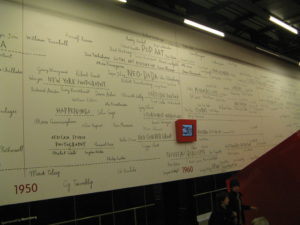Recently we returned from a once-in-a-lifetime celebration (40 years married!) in London and the British countryside. There was so much to see, enjoy and think about that I found myself writing 13 poems on the flight home, next to my sleeping husband. The low point of the things discovered was at the celebrated Tate Modern, what a sorry disappointment! They did not have displayed what I had hoped to see there, and instead had a shambles of selections in a warehouse kind of a space. It was as if the emperor had been discovered naked and malnourished.
 This timeline, which stretched way farther, illustrates the fragmentation of hope and ideas, like shrapnel, that have occurred since WW2. Surely both wars in the 20th century set the ground for much despair in worldview. And the art, especially in Europe that came after, illustrates that. The only interesting work was where a few, like Joseph Beuys faced despair, and articulated it with intelligent concern. Despair alone multiplies despair however, and even more fragmentation. We could not wait to get out of there, actually.
This timeline, which stretched way farther, illustrates the fragmentation of hope and ideas, like shrapnel, that have occurred since WW2. Surely both wars in the 20th century set the ground for much despair in worldview. And the art, especially in Europe that came after, illustrates that. The only interesting work was where a few, like Joseph Beuys faced despair, and articulated it with intelligent concern. Despair alone multiplies despair however, and even more fragmentation. We could not wait to get out of there, actually.
This set us up however to go back over to Trafalgar square, where we had learned earlier there was a concert at St. Martin in the Fields. Oh, what a respite that was! This church has a vibrant understanding of its mission in that city. The concert, mostly Handel, was superb. The sanctuary is where Handel played his first recital in 1726! The crypt below was well arranged for feeding the crowds who come to this place. And they had several art shows going on down there and above that were astoundingly interesting. One grouping, “Odyssey,” was a series of wooden figures done by a Brit of Polish ancestry who, in his search for spiritual roots went back to the land and the trees among which his mother walked as she migrated through the horror of the war. The figures stand as sentries overlooking the diverse crowds in the square beyond the church. They are a silent warning. The other show we loved was “110Faces,” which was a collection of photo portraits of common and not so common Londoners. It was a celebration of the uniqueness, and the amazing victory of diversity in the human image of God that we all are.
And on the portico was a sculpture that was compellingly moving, illustrating John’s gospel chapter 1:1 and verse 14: “and the word became flesh and dwelt among us, and we beheld his glory. . . ” This tied it all together. Though the despair is ever present and remains, His indwelling is the reason there is hope of any substance, and ideas that are worth illustrating.